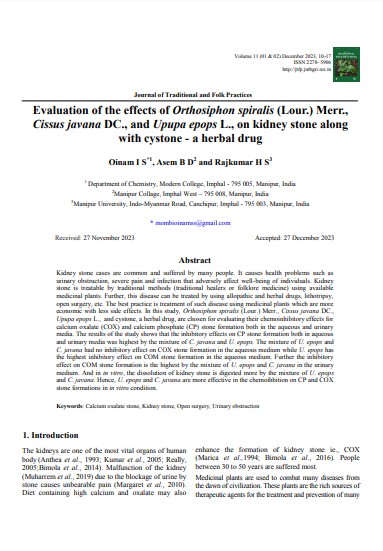Evaluation of the effects of Orthosiphon spiralis (Lour.) Merr., Cissus javana DC., and Upupa epops L., on kidney stone along with cystone - a herbal drug
Keywords:
Calcium oxalate stone, Kidney stone, Open surgery, Urinary obstructionAbstract
Kidney stone cases are common and suffered by many people. It causes health problems such as urinary obstruction, severe pain and infection that adversely affect well-being of individuals. Kidney stone is treatable by traditional methods (traditional healers or folklore medicine) using available medicinal plants. Further, this disease can be treated by using allopathic and herbal drugs, lithotripsy, open surgery, etc. The best practice is treatment of such disease using medicinal plants which are more economic with less side effects. In this study, Orthosiphon spiralis (Lour.) Merr., Cissus javana DC., Upupa epops L., and cystone, a herbal drug, are chosen for evaluating their chemoinhibitory effects for calcium oxalate (COX) and calcium phosphate (CP) stone formation both in the aqueous and urinary media. The results of the study shows that the inhibitory effects on CP stone formation both in aqueous and urinary media was highest by the mixture of C. javana and U. epops. The mixture of U. epops and C. javana had no inhibitory effect on COX stone formation in the aqueous medium while U. epops has the highest inhibitory effect on COM stone formation in the aqueous medium. Further the inhibitory effect on COM stone formation is the highest by the mixture of U. epops and C. javana in the urinary medium. And in in vitro, the dissolution of kidney stone is digested more by the mixture of U. epops and C. javana. Hence, U. epops and C. javana are more effective in the chemoihbition on CP and COX stone formations in in vitro condition.


